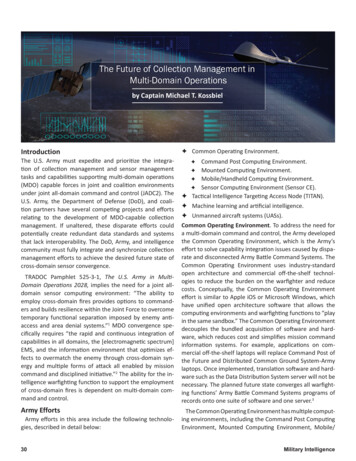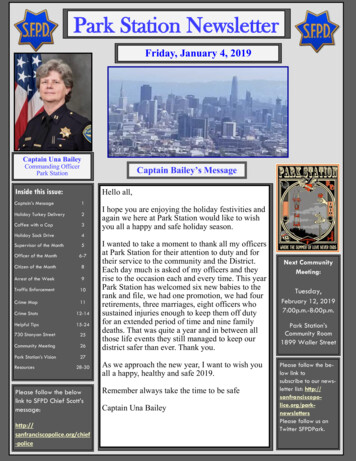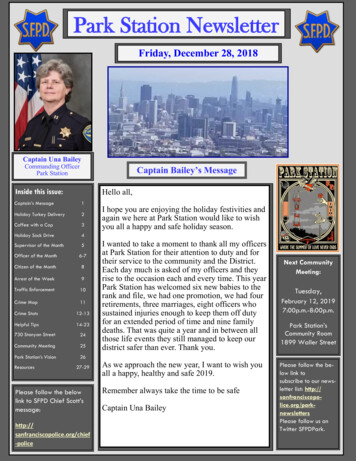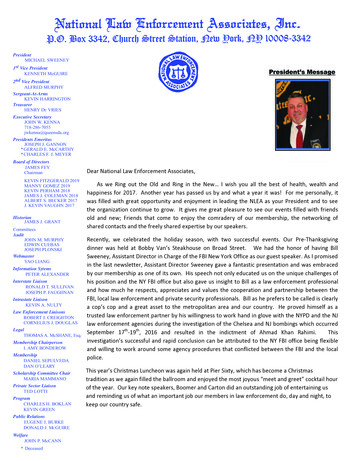
Transcription
by Captain Michael T. KossbielIntroductionThe U.S. Army must expedite and prioritize the integration of collection management and sensor managementtasks and capabilities supporting multi-domain operations(MDO) capable forces in joint and coalition environmentsunder joint all-domain command and control (JADC2). TheU.S. Army, the Department of Defense (DoD), and coalition partners have several competing projects and effortsrelating to the development of MDO-capable collectionmanagement. If unaltered, these disparate efforts couldpotentially create redundant data standards and systemsthat lack interoperability. The DoD, Army, and intelligencecommunity must fully integrate and synchronize collectionmanagement efforts to achieve the desired future state ofcross-domain sensor convergence.TRADOC Pamphlet 525-3-1, The U.S. Army in MultiDomain Operations 2028, implies the need for a joint alldomain sensor computing environment: “The ability toemploy cross-domain fires provides options to commanders and builds resilience within the Joint Force to overcometemporary functional separation imposed by enemy antiaccess and area denial systems.”1 MDO convergence specifically requires “the rapid and continuous integration ofcapabilities in all domains, the [electromagnetic spectrum]EMS, and the information environment that optimizes effects to overmatch the enemy through cross-domain synergy and multiple forms of attack all enabled by missioncommand and disciplined initiative.”2 The ability for the intelligence warfighting function to support the employmentof cross-domain fires is dependent on multi-domain command and control.Army EffortsArmy efforts in this area include the following technologies, described in detail below:30ÊÊ Common Operating Environment.ÊÊ Command Post Computing Environment.ÊÊ Mounted Computing Environment.ÊÊ Mobile/Handheld Computing Environment.ÊÊ Sensor Computing Environment (Sensor CE).ÊÊ Tactical Intelligence Targeting Access Node (TITAN).ÊÊ Machine learning and artificial intelligence.ÊÊ Unmanned aircraft systems (UASs).Common Operating Environment. To address the need fora multi-domain command and control, the Army developedthe Common Operating Environment, which is the Army’seffort to solve capability integration issues caused by disparate and disconnected Army Battle Command Systems. TheCommon Operating Environment uses industry-standardopen architecture and commercial off-the-shelf technologies to reduce the burden on the warfighter and reducecosts. Conceptually, the Common Operating Environmenteffort is similar to Apple iOS or Microsoft Windows, whichhave unified open architecture software that allows thecomputing environments and warfighting functions to “playin the same sandbox.” The Common Operating Environmentdecouples the bundled acquisition of software and hardware, which reduces cost and simplifies mission commandinformation systems. For example, applications on commercial off-the-shelf laptops will replace Command Post ofthe Future and Distributed Common Ground System-Armylaptops. Once implemented, translation software and hardware such as the Data Distribution System server will not benecessary. The planned future state converges all warfighting functions’ Army Battle Command Systems programs ofrecords onto one suite of software and one server.3The Common Operating Environment has multiple computing environments, including the Command Post ComputingEnvironment, Mounted Computing Environment, Mobile/Military Intelligence
Handheld Computing Environment, and Sensor CE.4 SensorCE established a unified (sensor) data model that enablesArmy-wide sensors to feed (directly or indirectly) the common operational picture (COP). Sensor CE’s common datamodel reduces latency and removes the need for workarounds, thereby shortening the sensor-to-shooter linkageby standardizing data across multiple current and futuresensor programs of record. Essentially, Sensor CE allowsthe network to do the hard work of getting data to thecustomer. Sensor CE enables the interoperability and integration of sensors and sensor data to the network, othersensors, and consuming applications. Furthermore, SensorCE requires future sensors and sensor data to be discoverable, visible, accessible, understandable, trusted, and interoperable across the Common Operating Environment.The current solution for Sensor CE is the IntegratedSensor Architecture being developed at the U.S. ArmyCombat Capabilities Development Command’s Command,Control, Communications, Computers, Cyber, Intelligence,Surveillance, and Reconnaissance (C5ISR) Center.5United States-based intelligence production and data hosting limits the Army’s ability to effectively engage dynamicand time-sensitive targets. In the future, resilient multidomain ground stations must integrate sensor data in aseamless, dynamic, and continuous manner to generate effects in and from all domains.7Machine Learning and Artificial Intelligence. The Army isinvestigating machine learning and artificial intelligence capabilities to support collaboration and mission command.The first goal is to reduce the amount of time between target detection and applied effects in the close fight by an order of magnitude through robust sensor data integration atthe tactical edge. Key to this project is a synchronized datamanagement strategy that will enable access to the appropriate data and format assisted by artificial intelligence andmachine learning to aid in target detection and decisionsupport. The second goal is by 2028 to deliver multi-sensor, multi-platform target correlation; artificial intelligenceaided decision making; automated system behaviors; andmanned-unmanned teaming. Beyond 2028, the goal is todeliver tactical/operational artificial intelligence integration, artificial intelligence tasking of autonomous systems,and whole-theater data integration.8U.S. Army photo by SPC Dustin D. BivenThe Integrated Sensor Architecture is a technically mature, government-owned solution that is low cost andhas been fielded with several sensors.6 In 2019, the C5ISRCenter and the Program Executive Office forIntelligence, Electronic Warfare and Sensorshosted a demonstration of this capability in Virginia. During the demonstration, anetwork of Integrated Sensor Architectureenabled sensors demonstrated a sensor-toshooter capability by linking several sensorsto a Containerized Weapon System. Sensordata was passed seamlessly from sensors tothe Containerized Weapon System, enablingthe system to rapidly engage targets. Fieldingof the first instantiation of Sensor CE capabilities will occur in fiscal year 2023. Afterthat time, the Sensor CE will integrate withadditional Common Operating EnvironmentThe Army is trying to move away from runway-dependent and cumbersome UAS in favor of UAS that bringcomputing environments.advanced teaming capabilities.Tactical Intelligence Targeting Access Node. In addition tothe Common Operating Environment, the U.S. Army is developing TITAN. TITAN is a scalable and expeditionary intelligence ground station that will support commanders acrossthe entire MDO battlefield framework with capabilities tailored by echelon. TITAN leverages space, high-altitude, aerial, and terrestrial layer sensors to provide targetable datato the fires networks as well as multidiscipline intelligencesupport to targeting and situational understanding in support of mission command. Overreliance on continentalJuly–September 2020Unmanned Aircraft Systems. Program Manager, UAS isspearheading several projects related to collection management. One project, air-launched effects, is a family of systems designed to provide UAS capabilities launched fromaircraft to autonomously or semiautonomously deliver effects as a single agent or as a member of a team. 9 “Servingas an [air-launched effects] ALE mothership, the [Gray EagleExtended Range] GE-ER will carry multiple ALEs with a varietyof capabilities,” and that “launching and controlling of ALEsfrom the GE-ER could potentially increase the survivability31
and effectiveness of current and future manned aviationsystems with intelligence, targeting, communications, jammers, decoys, and kinetic effects.”10Program Manager, UAS is also developing a new UAS platform interface control software suite that will allow authorized users to control selected assets from a missioncommand information system via a web application programming interface. The new software provides a capabilityto request several different levels of control, including monitoring of the platform and payloads, control of the sensorpayload while monitoring the platform, control of the sensor payload, and limited control of the platform (single waypoints). The new software eliminates the need for groundcontrol stations by providing flexible control through laptops and tablets that can be anywhere on the battlefield.are developing. The operational management of UAS andunmanned ground system swarms allows users to defineand prioritize swarm reconnaissance tasks, and it uses artificial intelligence to automate resource allocation to complete the reconnaissance tasks.12 During the demonstration,in near real time, the swarm updated a three-dimensionalCOP on laptops and on augmented reality headsets.Future Risks for Collection ManagementTo achieve “the rapid and continuous integration of capabilities in all domains” necessary for MDO cross-domainconvergence, all the collection modernization efforts muststandardize data and the command and control of sensors.The standardization of sensor data and command and control technology across the Army and joint force must be integrated and synchronized to achieve the volume and speedof delivery necessary to defeat peer adversaries. In the nearJoint and International EffortsUnified sensor data standards not only create interop- future, the number of sensors, volume of data, and collecerability with U.S. Army sensors but will also enable in- tion requirements will overwhelm already undermannedteroperability for joint and coalition partners. For instance, collection management cells. The increase of data and colAmerican, British, Canadian, Australian, and New Zealand lection requirements with the cognitive overwhelming of(ABCANZ) doctrinal and technical interoperability standards collection managers risks a break with the seven fundawould enable sensor-to-shooter linkages across coalition mentals of reconnaissance.13 Standardization and automatask forces. Future international agreements on sensor data tion are necessary to ensure continuous reconnaissance,interoperability and security enclave agreements will en- rapid and accurate reporting of information, and the abilityable an integrated sensor-to-shooter linkage within a mul- to keep reconnaissance, sensors, and collectors in the fighttinational coalition division headquarters with subordinate (and not in reserve). In order to accomplish this, the authorABCANZ force elements. In addition to coalition sensor in- recommends that the DoD and the Army establish a collecteroperability, the DoD is developing the JADC2 concept. tion management cross-cutting capability to fully integrateand synchronize all collection efJADC2 requires any sensor toforts on the MDO battlefield.provide data to any shooter, inThe Seven Fundamentals of Reconnaissancecluding joint and coalition partThe Army must prioritize theThe seven fundamentals of reconnaissance are—ners. The JADC2 cross-functionalcreation of a singular conceptual,ÊÊ Ensure continuous reconnaissance.team is led by the U.S. Air Force,doctrinal, and materiel developÊÊ Do not keep reconnaissance assets in reserve.which is developing conceptsmental strategy to fully integrateÊÊ Orient on the reconnaissance objective.and requirements for a materiela future collection managementÊÊ Report information rapidly and accurately.solution to enable joint sensorMDO-ready capability. The ArmyÊÊ Retain freedom of maneuver.to-shooter links.should pursue the developmentÊÊ Gain and maintain enemy contact.of a collection managementThe Defense Advanced ReÊÊ Develop the situation rapidly.14cross-cutting capability thatsearch Projects Agency’s (DARPA)fully integrates Army CapabilityO F Fe n s i ve Swa r m - E n a b l e dTactics program is developing UAS swarm technology that Manager Foundation’s collection management applica“envisions future small-unit infantry forces using swarms tion and Sensor CE’s data standards and services. The colcomprising upwards of 250 unmanned aircraft systems lection management cross-cutting capability would createand/or unmanned ground systems to accomplish diverse a digital solution to bridge the gap between collection remissions in complex urban environments.’’11 In December quirements management; collection operations manage2019 at Camp Shelby, Mississippi, DARPA conducted a dem- ment; and processing, exploitation, and disseminationonstration of the OFFensive Swarm-Enabled Tactics tech- (PED) across the Command Post Computing Environment,nology, including the operational management of swarm Mounted Computing Environment, Mobile/Handheldtactics that Carnegie Mellon University and Soar Technology Computing Environment, JADC2, and coalition partners.32Military Intelligence
with data providers (collectors, sensor managers,and sensors). The collectionmanagement cross-cuttingcapability will reduce theburden on collection managers by standardizing dataand digital planning toolsand by digitizing a standardrequest for collection, a sensor COP, and digital collector/sensor tasks through acommon collection management application anddata standard.To achieve full operationalintegration, the collectionmanagement cross-cuttingcapability will fully standardize and link threat datato collection requirementsand sensor alerts. Threatdata imported from the military intelligence All-SourceFigure 1. Collection Management Cross-Cutting Capability Conceptual ViewThe Army should pursue and develop an incremental and App must be able to automatically provide enemy order ofholistic strategy for implementing automation and artificial battle information, including individual object/unit identiintelligence/machine learning into collection management. fication. Additionally, technical data must be automaticallyThe collection management cross-cutting capability will imported and created into specific information requireprovide data users (consumers) a direct digital connection ments and technical indicators. A common data model mustdigitally link enemy orderof battle, enemy coursesof action, event templates,collection plans, and automated collector and sensortasks. For instance, an analyst creates a named areaof interest (NAI) for an enemy tank battalion. Themetadata associated withthe enemy tank battalionwill be digitally linked withspecific NAIs and alignedto a priority intelligence requirement. The collectionrequirement for the enemytank battalion will then beimported into the CollectionManagement App for futureplanning. The CollectionFigure 2. Common Operating Environment Collection Management Conceptual OverviewManagement App will makeJuly–September 202033
recommendations on what collection assets and sensorsare available to task and what higher assets are availablethat could collect on the requirement. Once the collectionmanager assigns an approved collection asset for the tankbattalion, sensor tasks, with the associated metadata, aresent to sensor managers via the Sensor CE. An example ata future brigade combat team would be as follows: A terrestrial collection system is tasked with conducting an areareconnaissance of the specific tank battalion’s NAI, and theterrestrial sensor operators will have access to all technicalmetadata related to the associated enemy tank battalion order of battle, course of action, and event template.The collection management cross-cutting capability willcreate an end-to-end digital feedback loop for data consumers and collectors to ensure that information is reportedrapidly and accurately. This will be achieved by standardizing requests for collection on a single cloud-based application. The Collection Management App will allow requestors,collection managers, and sensor managers to track requestsand collection tasks and provide real-time feedback on thestatus of requests. Additionally, a digital link will be created between data consumers and tasked sensors throughSensor CE’s automated sensor alerts and subscriptions.Once a request for collection is approved and a collector orsensor is assigned, the consumer will automatically be subscribed to the sensor’s alerts.The collection management cross-cutting capability willenable the creation of a user-defined COP tailored to thecollection mission. Users will have the ability to visually depict sensor and collection management data on a CommandPost Computing Environment layer of the COP. The sensorlayer of the COP will be visible on the move and at the haltfrom the Command Post Computing Environment, MountedComputing Environment, and Mobile/Handheld ComputingEnvironment. The sensor layer of the COP allows leadersand users to understand current collection and sensor operations. In addition, sensor data users will be able to viewcollection management plans such as a synchronization matrix and NAIs.The collection management cross-cutting capability willenable the control of sensors via the network rather than“at the sensor source.” By digitally linking requests for collection with sensor control software, we will in effect createthe “network of things” of intelligence, surveillance, and reconnaissance. The Collection Management App, Sensor CE,emerging sensors or platforms, and future ground controlstation software will allow consumers such as infantry or armor company commanders to digitally submit requests forcollection on their mounted or dismounted end-user devices and receive direct support from higher-level collectionassets. The networked control of sensors will allow users todevelop the situation rapidly, retain freedom of maneuver,and gain and maintain enemycontact more efficiently.Figure 3. All-Source App to Sensor Data Linkage Concept34The collection managementcross-cutting capability willenable sensor-to-sensor automatic cueing. Sensor CE’ssensor-to-sensor data exchanges enable sensor-tosensor automatic cueing.Automatic cueing will allowcommanders or authorizedusers (collection managersand sensor managers) the capability to define sensor-tosensor cueing relationships.Authorized users will havethe ability via the CollectionManagement App’s PlanningTool to plan digital cueing relationships between two ormore sensors or collectors.Once collection managers establish a cueing relationshipMilitary Intelligence
between sensors, the system will automatically subscribethe cued sensor to the cueing sensor’s alerts. Cueing alertswill be sensor-to-sensor automatic and sensor-to-sensoroperator/manager for human-controlled sensors.In the long term, the collection management cross-cuttingcapability and Sensor CE will provide the underlying dataframework and services for automated, autonomous, andartificial intelligence-controlled sensor operations. Thesewill include preprogrammed automated sensors, dynamicautonomous sensors that react to the operational environment, and artificial intelligence-controlled sensors thatoperate using feedback loop algorithms. Conceptually, users will input information requirements into the CollectionManagement App where artificial intelligence will resource,task collection, and allocate PED to answer the requirement. The transition to automated, autonomous, and artificial intelligence-controlled collection management willalso necessitate the integration of cloud and artificial intelligence-enabled PED. The DoD’s and Army’s future initiatives,along with private sector innovations, will eventually provide artificial intelligence and machine learning algorithmsto identify military targets with a high level of accuracy.15 Forinstance, a British company is developing algorithms to apply machine learning to satellites’ imagery for the identification of military aircraft with a reported accuracy rate of 98percent.16 Additionally, Microsoft has built a sophisticatedsoftware capability that allows artificial intelligence/machine learning to detect various patterns that identify snowleopards in snowy terrain using images and data from gamecameras (camera traps). Biologists deploy motion-sensingcameras in the snow leopard habitat that capture imagesof snow leopards, prey, livestock, and anything else thatmoves. It then sorts through the images to find the oneswith snow leopards in order to learn more about their populations, behavior, and range. Over the years, these camerashave produced more than 1 million images. 17 The collectionmanagement cross-cutting capability will provide users withedge-to-cloud access and the ability to request/task automated, semiautonomous, and autonomous sensors and toreceive automated support with real-time sensor alerts.The DoD, the Joint Staff, and the Army need to create ajoint governing body that develops joint collection management concepts, doctrines, procedures, and technical standards. We can achieve MDO convergence of all sensors andall shooters only through the interoperability of doctrine,data, and network transport standards. Once the DoD establishes doctrinal and technical standard for collectionmanagement, it must expand interoperability to coalitionpartners in support of the mission partner environment.July–September 2020Interoperability with coalition partners, such as ABCANZ,will further enable MDO.ConclusionThe Army lacks sufficient capability to fully integrate andsynchronize all collection assets, sensors, and sensor datain real time to defeat a future peer threat in MDO andlarge-scale ground combat operations. The increase in thenumber of sensors, volume of data, and collection requirements will overburden future collection managers and willincrease the risk of violating the seven fundamentals of reconnaissance. In order to mitigate this risk and enable collection management, the Army must invest in a collectionmanagement cross-cutting capability that standardizes andautomates collection management command and control.This will provide the capability to discover, access, and manage interoperable sensor data from all warfighting functions, domains, and joint and coalition partners in supportof MDO.Endnotes1. Department of the Army, Training and Doctrine Command (TRADOC)Pamphlet 525-3-1, The U.S. Army in Multi-Domain Operations 2028 (FortEustis, VA: TRADOC, 6 December 2018), 19.2. Ibid., 20.3. “Command Post Computing Environment,” Program Executive OfficeCommand Control Communications-Tactical website, accessed 24 June 2020,https://peoc3t.army.mil/mc/cpce.php.4. Nancy Jones-Bonbrest, “Army forges ahead with Common OperatingEnvironment for mission command,” U.S. Army Worldwide News, October25, 2017, https://www.army.mil/article/195864/army forges ahead withcommon operating environment for mission command; and Departmentof the Army, Common Operating Environment (Washington, DC, October2015), https://asc.army.mil/web/wp-content/uploads/COE Flip Book.pdf.5. Kevin McCaney, “Next step for tactical nets: Sensors that know how toshare,” Defense Systems, January 9, 2015. aspx; and U.S. Army CCDC C5ISR Center, “CERDEC Integrated SensorArchitecture,” YouTube video, 3:59, April 6, 2015, https://www.youtube.com/channel/UCuKIFn85 cr0pfHd5pCk84w.6. Christine L. Moulton, Susan Harkrider, John Harrell, and Jared Hepp,Integrated Sensor Architecture (ISA) for Live Virtual Constructive (LVC) Environments (27 March 2014), https://apps.dtic.mil/docs/citations/ADA636887.7. Sean Kimmons, “TITAN system being developed to tie ‘deep sensing’ tolong-range fires,” U.S. Army Worldwide News, October 24, 2019, https://www.army.mil/article/228867/titan system being developed to tiedeep sensing to long range fires.35
8. Ashley Tressel, “Martin: ‘Project Convergence’ to explore Army’s role inJADC2,” Inside Defense, March 10, 2020, onvergence-explore-armys-role-jadc2; and Patrick Tucker,“The US Army Wants to Reinvent Tank Warfare with AI,” Defense One,October 18, 2019, my-wants-reinvent-tank-warfare-ai/160720/.9. Kerensa Crum, “CCDC Aviation, Missile Center highlights forward-launchedUAS technology,” U.S. Army Worldwide News, March 30, 2020, https://www.army.mil/article/234100/ccdc aviation missile center highlights forwardlaunched uas technology.10. Jed Judson, “General Atomics demos Gray Eagle’s role in multidomainops,” Defense News, January 22, 2020, /; and Jed Judson, “US Army to launch drone from helicopter for firsttime this year,” Defense News, May 1, 2018, -for-first-time-this-year/.11. “OFFensive Swarm-Enabled Tactics (OFFSET),” Defense AdvancedResearch Projects Agency, accessed 24 June 2020, -enabled-tactics.12. Kelsey D. Atherton, “DARPA want commanding robots to work like avideo game,” C4ISRNet, February 11, 2020, .13. Paragraphs 1-37 through 1-44 of FM 3-55, Information Collection,discuss the seven fundamentals of reconnaissance in relation to informationcollection activities. Department of the Army, Field Manual 3-55, InformationCollection (Washington, DC: U.S. Government Publishing Office, 3 May 2013),1-7, 1-8.14. Ibid., 1-7.15. Charlie Kawasaki, “6 Ways AI can make sense of sensor data in 2020,”C4ISRNet, February 14, 2020, 20/.16. “Battle algorithm: Artificial intelligence is changing every aspect of war,”The Economist, September 7, 2019, -aspectof-war.17. Mark Hamilton, Sudarshan Raghunathan, Akshaya Annavajhala, DanilKirsanov, Eduardo de Leon, Eli Barzilay, Ilya Matiach, Joe Davison, MaureenBusch, Miruna Oprescu, Ratan Sur, Roope Astala, Tong Wen, and ChangYoungPark, “Flexible and Scalable Deep Learning with MMLSpark,” Proceedings ofMachine Learning Research 82 (October 2017): 11–22, ton18a.pdf; and Databricks, “MicrosoftAnnounces Support for MLflow, Delta Lake and More–Rohan Kumar(Microsoft),” YouTube video, 23:11, April 25, 2019, https://www.youtube.com/watch?v T fs4C0aqD0&feature youtu.be&t 425.CPT Michael Kossbiel is the commander of Headquarters and Headquarters Company, U.S. Army Intelligence Center of Excellence. His previousassignments include sensor computing environment team lead, Intelligence-Capabilities Development and Integration Directorate, ArmyFutures Command; assistant S-2 for 3rd Armored Brigade Combat Team, 1st Cavalry Division; battalion S-2 for 215th Brigade Support Battalion;and intelligence advisor to the Royal Saudi Land Forces under Joint Special Operations Task Force-Arabian Peninsula. He is a graduate of ArmorBasic Officer Leaders Course, Military Intelligence Officer Transition Course, and Military Intelligence Captains Career Course.36Military Intelligence
and effectiveness of current and future manned aviation systems with intelligence, targeting, communications, jam-mers, decoys, and kinetic effects."10 Program Manager, UAS is also developing a new UAS plat-form interface control software suite that will allow au-thorized users to control selected assets from a mission










